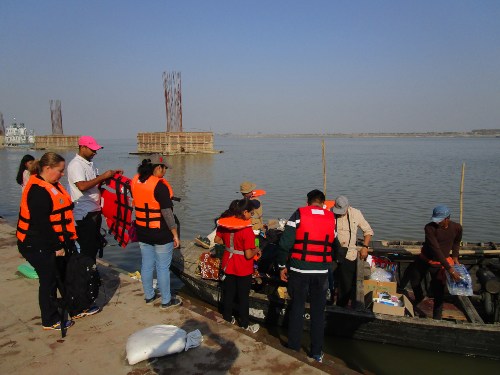
Tackling groundwater arsenic and health inequalities in India
Dr David Polya, Professor of Environment Geochemistry and Associate Dean for Internationalisation in the Faculty of Science and Engineering, discusses the impact of arsenic in groundwater and the danger it poses to the long-term health of people consuming it.
The news over the last year has been dominated by COVID-19, but beyond the disease, the geographic distribution of case numbers has highlighted profound underlying inequalities in lifetime health outcomes, both between and within countries. In many poor, rural communities across the globe, those inequalities arise from greater risks of exposure to high concentrations of arsenic in groundwater used as drinking water – a particular issue in the Indian subcontinent, where, as a result, more than 100,000 people are estimated to die prematurely every year.
Our research into groundwater arsenic in northern India focuses on where it is, how it gets there, what the impact on people’s health is and what solutions might work in order to help. We’re addressing several United Nations Sustainable Development Goals (SDGs), particularly SDG Goal 6: Clean water and sanitation.
Uniquely modelling groundwater arsenic
Our research largely takes place in the Ganges River Basin, where much of this natural environmental chemical hazard is found. We have, however, recently produced the first India-specific all-country machine learning model of groundwater arsenic and this shows that high groundwater arsenic likely also exists in some areas of southern India.

Our collective research has shown that certain types of microbes promote release of arsenic into groundwater from sub-surface solid aquifer materials; has identified sources and ages of organic matter involved in this release; and highlighted how massive withdrawal of groundwater for irrigation might be making the problem worse.
Impact and risks to health
We’re currently working on quantifying the health risks arising both indirectly and directly from groundwater use in India and elsewhere, demonstrating an association between deaths from cardiovascular disease and even low-level exposure to arsenic from drinking water.
Our research also highlights the importance of rice as an exposure route for inorganic arsenic. It shows the link between the consumption of higher arsenic rice as a staple in people's diet and genetic damage known to be associated with various cancers. Those who eat high arsenic rice have more genetic damage to their bodies than those who eat low arsenic rice, so our recommendations have focused on rice preparation techniques people can use to help protect their health.
Our research into groundwater arsenic in northern India focuses on where it is, how it gets there, what the impact on people’s health is and what solutions might work in order to help.
Dr David Polya / Professor of Environment Geochemistry
Finding solutions to arsenic in groundwater
Although there is no single solution to India’s groundwater arsenic problems, our research highlights approaches that may be helpful. Our models of the distribution of arsenic in groundwater and of the health impacts of people’s exposure to this arsenic enable the benefits to public health from different mitigation approaches to be better quantified. This underpins improving the selection and adoption of arsenic mitigation approaches, including through the education and proactive empowerment of women in economically disadvantaged rural communities.
Researching with international partnerships
Optimising solutions to this complex problem requires partnership, co-design and input from multiple and diverse areas of expertise.
Our research is currently being done as part of a joint India-UK water quality project, FAR-GANGA, in collaboration with key India institutions, notably the National Institute of Hydrology, IIT Roorkee, IIT Kharagpur and the Mahavir Cancer Sansthan (Hospital and Research Centre), with advice from the Central Groundwater Board, Public Health Engineering departments and NGOs.
Our work with our new colleagues has been enlightening and inspiring, teaching us more than we could have imagined about the issues at hand, yet also allowing us the privilege to immerse ourselves in the rich culture of India.
Related research
Find out how Dr Laura Richards, a Dame Kathleen Ollerenshaw Research Fellow (Academic), is creating understanding and impact through groundwater quality research in Bihar.
Read more
Global influence
Explore the international partnerships we’re forging to deliver solutions to global challenges.
Read more

